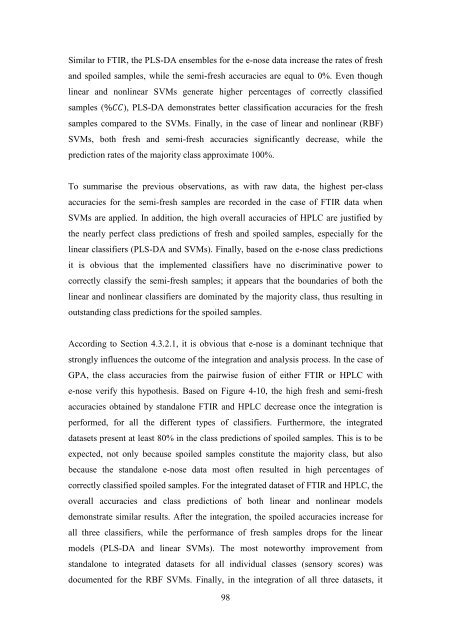CRANFIELD UNIVERSITY Eleni Anthippi Chatzimichali ...
CRANFIELD UNIVERSITY Eleni Anthippi Chatzimichali ...
CRANFIELD UNIVERSITY Eleni Anthippi Chatzimichali ...
You also want an ePaper? Increase the reach of your titles
YUMPU automatically turns print PDFs into web optimized ePapers that Google loves.
Similar to FTIR, the PLS-DA ensembles for the e-nose data increase the rates of fresh<br />
and spoiled samples, while the semi-fresh accuracies are equal to 0%. Even though<br />
linear and nonlinear SVMs generate higher percentages of correctly classified<br />
samples ( ), PLS-DA demonstrates better classification accuracies for the fresh<br />
samples compared to the SVMs. Finally, in the case of linear and nonlinear (RBF)<br />
SVMs, both fresh and semi-fresh accuracies significantly decrease, while the<br />
prediction rates of the majority class approximate 100%.<br />
To summarise the previous observations, as with raw data, the highest per-class<br />
accuracies for the semi-fresh samples are recorded in the case of FTIR data when<br />
SVMs are applied. In addition, the high overall accuracies of HPLC are justified by<br />
the nearly perfect class predictions of fresh and spoiled samples, especially for the<br />
linear classifiers (PLS-DA and SVMs). Finally, based on the e-nose class predictions<br />
it is obvious that the implemented classifiers have no discriminative power to<br />
correctly classify the semi-fresh samples; it appears that the boundaries of both the<br />
linear and nonlinear classifiers are dominated by the majority class, thus resulting in<br />
outstanding class predictions for the spoiled samples.<br />
According to Section 4.3.2.1, it is obvious that e-nose is a dominant technique that<br />
strongly influences the outcome of the integration and analysis process. In the case of<br />
GPA, the class accuracies from the pairwise fusion of either FTIR or HPLC with<br />
e-nose verify this hypothesis. Based on Figure 4-10, the high fresh and semi-fresh<br />
accuracies obtained by standalone FTIR and HPLC decrease once the integration is<br />
performed, for all the different types of classifiers. Furthermore, the integrated<br />
datasets present at least 80% in the class predictions of spoiled samples. This is to be<br />
expected, not only because spoiled samples constitute the majority class, but also<br />
because the standalone e-nose data most often resulted in high percentages of<br />
correctly classified spoiled samples. For the integrated dataset of FTIR and HPLC, the<br />
overall accuracies and class predictions of both linear and nonlinear models<br />
demonstrate similar results. After the integration, the spoiled accuracies increase for<br />
all three classifiers, while the performance of fresh samples drops for the linear<br />
models (PLS-DA and linear SVMs). The most noteworthy improvement from<br />
standalone to integrated datasets for all individual classes (sensory scores) was<br />
documented for the RBF SVMs. Finally, in the integration of all three datasets, it<br />
98
















